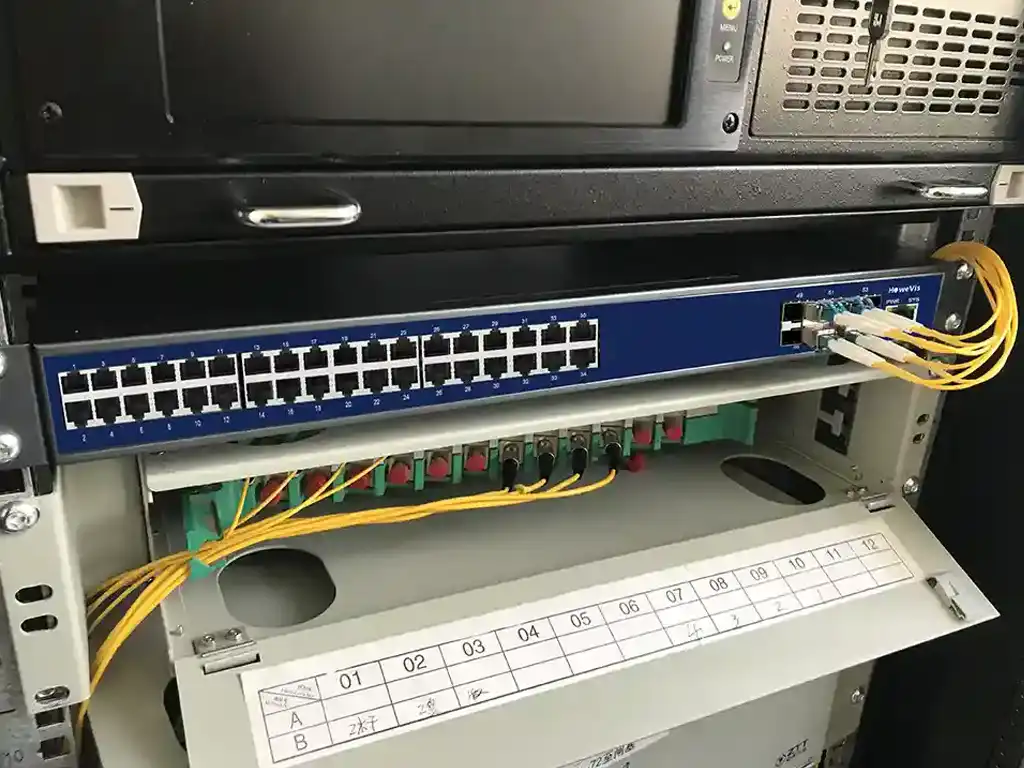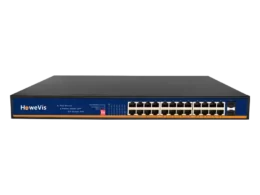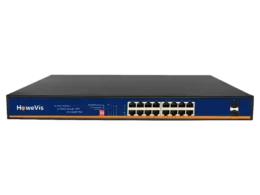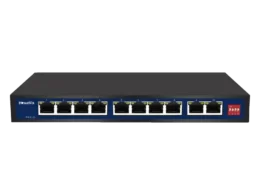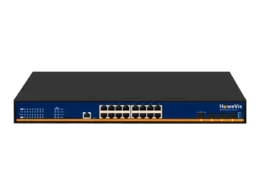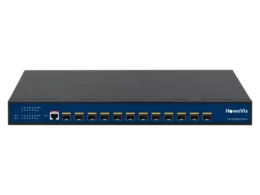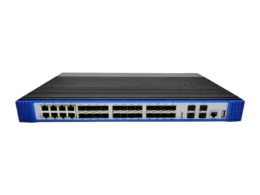Are you tired of dealing with the hassle of separate power cables for your network devices? Introducing PoE hubs – the game-changer in simplifying network setups. With a PoE hub, you can now transmit power and data over a single Ethernet cable, eliminating the need for multiple cords and outlets.
PoE hubs are an ideal solution for small-scale deployments requiring fewer ports. They offer a cost-effective way to power PoE-enabled devices such as IP cameras and wireless access points. Whether you’re a small business, tech startup, or design firm, a PoE hub ensures consistent connectivity and secure networking. Plus, with features like gigabit Ethernet switches and managed injector hubs, you can easily configure and manage your network with ease.
Say goodbye to tangled cables and hello to simplified network solutions. Get ready to streamline your network setup and enjoy peace of mind knowing that your connected devices are powered efficiently.
What is a PoE hub switch?
A PoE hub switch is an awesome switch that combines the functionality of a traditional Ethernet switch with Power over Ethernet capabilities. It allows for both data communication and power delivery to connected devices. With multiple ports, it can support numerous network connections simultaneously.
Simultaneous Data and Power Delivery
One of the key advantages of a PoE hub switch is its ability to provide both data and power to connected devices. This eliminates the need for separate power supplies or PoE injectors, simplifying the setup and reducing clutter. Whether you’re connecting IP cameras, wireless access points, or VoIP phones, a PoE hub switch ensures they receive the necessary data connection and power supply through a single cable.
Scalability for Larger Networks
A PoE hub switch is an ideal choice for larger networks requiring more ports and higher bandwidth. These switches come in various configurations, ranging from 8-port switches suitable for small businesses to 48-port switches designed for enterprise-level networks. The availability of multiple ports allows for easy expansion as your network grows.
Flexibility and Convenience
PoE hub switches offer flexibility and convenience by providing power directly through the Ethernet cables used for data transmission. This means that you can deploy devices in locations where electrical outlets may not be readily available or accessible. It also simplifies cable management since there’s no need to run separate power cables alongside Ethernet cables.
Cost-Effective Solution
By combining data and power delivery into a single infrastructure, PoE hub switches offer cost savings compared to traditional setups that require separate cabling for data and power. This reduces installation costs and ongoing maintenance expenses associated with managing multiple cables.
Enhanced Network Efficiency
With a PoE hub switch, you can optimize network efficiency by prioritizing critical devices or applications through Quality of Service (QoS) settings. This ensures that important traffic receives priority over less time-sensitive data, resulting in a smoother and more reliable network performance.
PoE Ethernet Hub vs PoE Ethernet Switch
In the world of Power over Ethernet (PoE) networking, two popular devices can help you distribute power and data efficiently: PoE Ethernet hubs and PoE Ethernet switches. While they may sound similar, these devices have distinct power distribution and functionality differences. Let’s dive into the comparison between a PoE Ethernet hub and a PoE Ethernet switch.
A PoE Ethernet hub distributes power equally among all its ports, regardless of device requirements.
A PoE hub is like an equal opportunity provider. It treats all connected devices equally by providing the same power to each port, regardless of their individual needs. This simplicity makes setting up a hub straightforward – just plug in your devices and they will receive power.
Pros:
- Easy setup with no configuration required.
- Suitable for basic networks with low-power devices.
- Cost-effective option compared to switches.
Cons:
- Inefficient use of power as all ports receive equal amounts, even if some devices require less.
- Limited control over power allocation.
- It may not support advanced features like VLANs or QoS prioritization.
In contrast, a PoE Ethernet switch intelligently allocates power based on individual device needs.
Unlike a hub, a PoE switch can intelligently allocate power based on the specific requirements of each connected device. This means that if a device requires less power than others, the switch will provide only what is needed, ensuring efficient use of resources. Switches offer greater flexibility and control over network management.
Pros:
- Intelligent power allocation ensures optimal use of available resources.
- Enhanced control over network management with features like VLAN support and QoS prioritization.
- Suitable for networks with varying device power requirements.
Cons:
- Requires some configuration for proper operation.
- Generally, it is more expensive than hubs due to added functionality.
- It may be overkill for simple networks with low-power devices.
Consider your network’s specific needs when deciding between a PoE Ethernet hub and a PoE Ethernet switch. A hub may suffice if you have a small, basic network with low-power devices; simplicity is key. However, a switch would be the better choice if you require more control over power allocation and advanced features like VLANs or QoS prioritization.
Understanding the Role of PoE Hubs in Networking
PoE hubs play a crucial role in simplifying network installation and management. They combine power and data transmission into a single cable, eliminating the need for separate electrical outlets near each device. This not only reduces clutter but also cuts down on installation costs.
Simplified Installation Process
With PoE hubs, you no longer have to worry about finding an available power outlet for each device on your network. By integrating power and data transmission, these hubs make connecting and power devices such as IP cameras, wireless access points, and VoIP phones easier. Plug in the Ethernet cable, and both data and power will be delivered simultaneously.
Reduced Clutter and Cost Savings
One of the major advantages of using PoE hubs is the reduced cable clutter. With traditional setups requiring separate cables for power and data, it’s easy for things to become messy and tangled. However, with PoE hubs, you can streamline your network by using just one cable per device.
By eliminating the need for additional electrical outlets near each device, PoE hubs also help save on installation costs. You won’t have to hire an electrician or invest in extra infrastructure to accommodate individual power connections.
Centralized Power Management
Another key benefit of PoE hubs is their ability to centralize power management. These hubs allow you to monitor and control the power consumption of connected devices remotely. This level of control provides valuable insights into energy usage patterns and allows for efficient allocation of resources.
For example, if certain devices consume excessive power during non-peak hours, you can adjust their settings or schedule them to enter a low-power mode when not in use. This helps optimize energy usage across your network.
Enhanced Network Reliability
In addition to simplifying installation and enabling centralized power management, PoE hubs enhance network reliability through built-in surge protection and short-circuit prevention.
PoE hubs protect connected devices from sudden voltage spikes or power surges by providing surge protection. This helps prevent device damage and ensures your network’s uninterrupted operation.
Furthermore, PoE hubs are designed to detect and prevent short circuits. In the event of a short circuit, the hub will automatically isolate the affected device, preventing it from disrupting the entire network.
Exploring Industrial-Grade PoE Hubs for Reliable Ethernet Connectivity
Industrial-grade PoE hubs are essential for networking setups, especially in demanding environments. These ruggedized hubs are designed to withstand harsh conditions such as extreme temperatures and high humidity. Let’s delve deeper into the features and applications of these robust devices.
Designed for Durability and Reliability
Industrial PoE hubs with sturdy components ensure consistent connectivity even in challenging settings. With their rugged construction, they can endure extreme temperatures ranging from -40 °C to 75°C (- 40°F to 167°F) without compromising performance. This makes them ideal for deployment in manufacturing plants, transportation systems, and outdoor installations where standard networking equipment may not be able to withstand the rigors of the environment.
Extended Power Budgets and Long-Distance Transmission
One of the key advantages of industrial-grade PoE hubs is their extended power budgets. They provide sufficient power to support various connected devices, including IP cameras, VoIP phones, access points, and other compatible devices. This eliminates the need for separate power sources or additional cabling infrastructure.
Moreover, these hubs often feature support for long-distance Ethernet transmission. They can reliably transmit data over distances up to 100 meters (328 feet), allowing for flexible device placement across large industrial spaces or outdoor areas.
Applications in Various Industries
Industrial PoE hubs find applications across a multitude of industries due to their durability and reliability. In manufacturing plants, they facilitate seamless communication between machinery and control systems by providing stable Ethernet connectivity. Transportation systems benefit from these hubs by ensuring uninterrupted data transmission between traffic management systems, surveillance cameras, and other connected devices.
Outdoor installations such as smart city projects rely on industrial-grade PoE hubs to establish reliable networks that connect sensors, lighting systems, security cameras, and more. These hubs play a crucial role in maintaining consistent connectivity under challenging environmental conditions.
Comparing PoE Hubs and Switches for Networking Needs
Choosing the right equipment is crucial. One important decision you’ll need to make is whether to use a PoE hub or a PoE switch. Both options have their advantages and considerations, so let’s dive in and compare them.
Number of Ports Required
The number of ports needed for your network is an essential factor to consider. If you have a small-scale deployment with only a few devices, a PoE hub may be sufficient. Hubs typically have fewer ports than switches, making them suitable for simpler setups.
On the other hand, if you have a larger network or one that requires advanced features like VLANs (Virtual Local Area Networks) or QoS (Quality of Service), a PoE switch would be recommended. Switches offer more flexibility in terms of port numbers and configurations, allowing you to expand your network as needed.
Bandwidth Requirements
Another aspect to consider when choosing between a PoE hub and switch is your network’s bandwidth requirements. A PoE switch would be the better choice if you have data-intensive applications or require high-speed connections.
Switches offer higher bandwidth options, such as Gigabit Ethernet or even 10 Gigabit Ethernet in some cases. This makes them ideal for handling large amounts of data quickly and efficiently. On the other hand, hubs usually have lower bandwidth capabilities, which may not be suitable for networks that demand fast transfer speeds.
Advanced Features
If your network requires advanced features like VLANs or QoS mentioned earlier, then a PoE switch is the way to go. Switches provide greater control over traffic management and allow you to segment your network into different virtual LANs based on specific criteria.
With VLANs, you can enhance security by separating sensitive devices from general ones while maintaining connectivity within each group. Moreover, switches offer QoS capabilities, allowing you to prioritize certain types of traffic over others. This is particularly useful in scenarios where real-time applications like VoIP (Voice over Internet Protocol) or video conferencing need to take precedence.
Features and Benefits of Industrial PoE Hubs
Industrial PoE hubs are a powerful networking solution that offers several features and benefits for businesses operating in demanding environments. Let’s take a closer look at what makes these hubs stand out from the crowd.
Redundant Power Inputs for Uninterrupted Operation
One of the key features of industrial PoE hubs is their ability to provide redundant power inputs. This means that even if one power source fails, the hub can switch seamlessly to an alternative power source, ensuring uninterrupted operation. This feature is crucial in industries where downtime can result in significant financial losses or compromise safety.
Wide Operating Temperature Ranges for Extreme Conditions
In harsh environments where temperatures can reach extreme highs or lows, standard networking equipment may struggle to function properly. However, industrial PoE hubs are designed to withstand such conditions. With wide operating temperature ranges typically ranging from -40°C to 75°C, these hubs can operate reliably in environments with extreme temperatures without compromising performance.
Fiber Optic Connectivity Options for Long-Distance Transmission
In some cases, businesses may require long-distance transmission without signal degradation. Industrial PoE hubs often offer fiber optic connectivity options to meet this need. By leveraging fiber optic technology, these hubs enable data transmission over much longer distances compared to traditional copper-based Ethernet connections. This capability is particularly beneficial in industries such as transportation and telecommunications.
Advanced Management Features for Remote Monitoring and Configuration
Industrial PoE hubs come equipped with advanced management features like SNMP (Simple Network Management Protocol), which allows for remote monitoring and configuration. With SNMP support, network administrators can easily monitor the status of connected devices, detect potential issues proactively, and make necessary configuration changes remotely without physically accessing each hub individually. This feature streamlines network management processes and reduces maintenance costs.
Optimizing Network Efficiency with Filtering by PoE Power and Budget
Filtering by PoE power is a crucial feature offered by certain PoE hubs that enable administrators to allocate power resources efficiently based on device requirements. This optimization plays a significant role in enhancing network efficiency while preventing damage or compatibility issues.
Efficient Power Allocation
With the ability to set power budgets individually per port or per connected device, administrators have greater control over power allocation. This means they can allocate the appropriate amount of power to each device based on its specific needs. By doing so, unnecessary power consumption is minimized, ensuring that devices receive only the required amount of power.
Preventing Compatibility Issues
Not all devices are created equal in terms of their power requirements. Some devices may require higher power output for optimal performance, while others may need less. Filtering by PoE power ensures that only compatible devices receive power from the hub. This prevents any potential damage caused by supplying excessive or insufficient power to a device.
Avoiding Overloading
Overloading a system can lead to network congestion and reduced performance. Administrators can prevent overloading the system by optimizing power allocation through filtering by PoE power. They can ensure that the hub’s total available power supply is distributed efficiently among all connected devices without exceeding its maximum capacity.
Enhancing Network Performance
Efficiently managing the distribution of DC (direct current) power across various devices helps maintain stable and reliable network speeds. By avoiding overloading and allocating sufficient but not excessive amounts of power, network performance is optimized, allowing for smooth data transmission and minimal latency.
Streamlining Device Management
Filtering by PoE power also simplifies device management for administrators. With this feature, they can easily identify which devices are receiving full-power units and which ones are operating at lower capacities due to their specific requirements. This information allows for better monitoring and troubleshooting capabilities.
Example Scenario
Let’s consider a scenario where an office environment has a mix of devices with varying power needs. The PoE hub in this case allows administrators to allocate power budgets individually per port or device. They can assign higher power budgets to devices such as IP cameras or access points that require more power for optimal functioning. Simultaneously, they can allocate lower power budgets to devices like VoIP phones or sensors that have lower power requirements. This targeted allocation ensures efficient use of available power resources while preventing overload and compatibility issues.
Setting Up a PoE Ethernet Hub or Switch: Simplified Installation Guide
Easy Installation Steps for the PoE Hub or Switch Series
Setting up a PoE Ethernet hub or switch doesn’t have to be complicated. With the easy installation process, you’ll have your network up and running in no time. Here’s a simplified guide to help you get started:
- Choose the Right PoE Hub or Switch: Before diving into the installation process, it’s crucial to select the right PoE hub or switch that suits your network requirements. Consider factors such as the number of ports, power budget, and compatibility with your devices.
- Prepare Your Equipment: Gather all the necessary equipment before starting the installation process. This includes your PoE hub or switch, Ethernet cables, and power source.
- Power Down Your Network Devices: To ensure a smooth installation process, it’s recommended to power down all your network devices before connecting them to the PoE hub or switch.
- Connect Your Devices: Begin by connecting one end of an Ethernet cable to each device you want to connect to the PoE hub or switch. Then, connect the other end of each cable to one of the available ports on the hub or switch.
- Connect Power Source: Once all your devices are connected via Ethernet cables, it’s time to provide power to your PoE hub or switch. Connect one end of a power cable to an electrical outlet and plug in the other end into the designated power input on your hub or switch.
- Power On Your Network Devices: After ensuring all connections are secure, power your network devices one by one. Allow some time for them to boot up and establish connections with each other through the PoE hub or switch.
- Verify Connectivity: Once everything is powered on and connected, verify connectivity by checking if all devices can communicate with each other. Test network connections, internet access, and any specific functionalities of your devices.
Pros and Cons of Using a PoE Hub or Switch
While setting up a PoE hub or switch offers numerous benefits, it’s essential to consider the pros and cons before making a decision. Here are some key points to keep in mind:
Pros:
- Simplified installation process for powering multiple devices through a single hub or switch.
- Reduced cable clutter by eliminating the need for separate power adapters for each device.
- Flexibility to add or remove devices from the network without disrupting the power supply.
- Improved network efficiency and reliability with centralized power management.
Cons:
- Limited power budget per port, which may restrict the types of devices you can connect.
- Higher initial cost compared to traditional Ethernet switches due to added PoE functionality.
- Potential compatibility issues with certain devices that do not support PoE.
Key Takeaways from the World of PoE Hub
In conclusion, understanding the world of PoE hubs is essential for anyone looking to optimize their network efficiency and simplify installation. By comparing PoE hubs and switches, you can determine which option best suits your networking needs. Industrial-grade PoE hubs offer reliable Ethernet connectivity, while also providing features such as filtering by PoE power and budget optimization. Setting up a PoE Ethernet hub or switch is made easy with simplified installation guides available.
To ensure you make an informed decision, consider your specific requirements and budget when choosing between a PoE hub and a switch. Remember, a well-designed network is like a smooth-running engine – it keeps everything connected seamlessly. So take charge of your network’s performance by exploring the world of PoE hubs today!
FAQs
Can I use a PoE hub with non-PoE devices?
Yes, you can use a PoE hub with non-PoE devices without any issues. The beauty of a PoE hub lies in its ability to supply power only to those devices that require it. So even if you connect non-PoE devices to the hub, they will function perfectly fine.
Are industrial-grade PoE hubs suitable for outdoor installations?
Absolutely! Industrial-grade PoE hubs are designed to withstand harsh environments, making them ideal for outdoor installations. They are built to be rugged and durable, capable of handling extreme temperatures and weather conditions.
Can I mix different brands of PoE devices on the same network?
Yes, you can mix different brands of PoE devices on the same network without any compatibility issues. The Power over Ethernet (PoE) standard ensures interoperability among various manufacturers’ products.
How many devices can I connect to a single PoE port?
The number of devices that can be connected to a single PoE port depends on the power requirements of those devices and the power budget of the PoE switch or hub. It is recommended to check the specifications of your PoE device and ensure it falls within the power limits supported by your switch or hub.
Can I use a PoE hub for video surveillance systems?
Yes, PoE hubs are commonly used in video surveillance systems. They provide both data connectivity and power supply to IP cameras, eliminating the need for separate power cables. This simplifies installation and reduces clutter in your surveillance setup.

